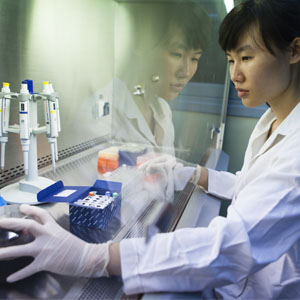Teams (EPATH)
BioGEPPE: Biology, Genetics and Pathology of Eukaryote Pathogens
Coordinator: Yvon STERKERS

Members:
Context and objectives:
Our team focuses on three themes: the study of the fundamental biological processes of trypanosomatids – Leishmania (responsible for leishmaniasis) and Trypanosoma brucei (responsible for sleeping sickness) –, genomics, and translational research.
The team is currently interested in DNA replication and chromosome segregation in these trypanosomatids, as well as several proteins associated with microtubules and involved in flagellar biogenesis and in post-translational modifications, particularly tubulin code. This team was the first to implement the CRISPR-Cas9 system on Leishmania (Sollelis et al.Cell Microbiol 2015) and more recently to develop an inducible KO system combining CRISPR-Cas9 and Di-CRE (Yagoubat et al. Cell Microbiol 2020). Request plasmids here.
For a pathogenic protozoan, adaptation to new hosts constitutes a key stage in epidemiology, its maintenance, and its dispersion. Genetic exchanges and notably hybridisations between different species can be the driving forces behind these rapid changes. The objective of this topic is both to better define the genetic entities making a species and their circulation over a long period as well as to evaluate interspecies genetic flows and post-hybridisation genomic evolution, and, more generally, to understand the intricate mechanisms involved in this evolution, which is essential for rapid adaptation. The models studied are leishmaniae and babesiae.
The team works out of Montpellier University Hospital, which has led to fruitful interactions between hospital practitioners, research professors, and researchers from different backgrounds, and has also promoted other translational studies concerning the diagnosis, identification, epidemiology, and pathology of parasites and fungi in human health. Several members of the team are affiliated with the Leishmaniasis National Reference Centre and / or du the Molecular Biology department of the Toxoplasmosis National Reference Centre.
GeneSys: From genes to ecosystems
Coordinator: Anne-Laure BANULS

Members:
-
Anne-Laure Bañuls
-
François Basseville
-
Julio Benavides
-
Inayat BHARDWAJ
-
Christian Carriere
-
Tepy Chanto
-
François Chevenet
-
Guilhem Conquet
-
Guillaume Constantin de magny
-
Chloé Dupont
-
Sylvain Godreuil
-
Juliette Hayer
-
Mallorie Hide
-
Danilo Kluyber de souza
-
Chrislène Laurens
-
Ella Marcy
-
Idris Mhaidi
-
Thai Son Nguyen
-
Kimyeun Oeurn
-
Marilia Salgado caxito
-
Phitsada Siphanthong
-
Baptiste Vergnes
-
Thomas Vitre
Context and objectives:
Context and objectives: Since January 2021, the GeneSys team has brought together members of IRD, CNRS, UM (University of Montpellier), and the University Hospital. This team focuses on infectious systems, from genes through to ecosystems. Its research is broken down into three thematic axes with a particular focus on antibiotic resistance and on the Sandfly/Leishmania model: 1. Emergence and transmission; 2. Adaptation and evolution; 3. Innovation and public health challenges. The programmes developed with these axes in mind aim to gain a better understanding of the way transmission foci work, further the development of innovative tools, and help with the implementation of public health policies. Our work covers various fields, such as functional biology, ecology, evolution, bioinformatics, molecular epidemiology, and public health. The team is particularly concerned with ensuring fair research partnerships with developing countries, as well as education and training.
The first axis – Emergence and transmission – describes and explains the emergence and transmission of human pathogens and drug resistance. This point studies various models and in particular sandflies and Leishmania, Mycobacterium tuberculosis, enterococci, bacteria involved in vaginosis, and Vibrio cholerae. Our research in this area is based on the One Health concept, with particular emphasis on human health, integrating field and clinical studies, genetics and genomics, microbiota, and spatiotemporal dynamics.
The second axis – Adaptation and evolution – studies adaptation phenomena, such as antimicrobial resistance, virulence, and pathogen-pathogen or host-pathogen interactions. By focusing on experimental models for which we boast strong expertise (Leishmania and sandflies, Mycobacterium, and other bacteria), we can explore the mechanisms that impact the biology of pathogens and their vectors (sandflies) and their transmission within human populations.
The third axis – Innovation and public health challenges – focuses on developing innovative tools for data analysis and improving the health of populations. The aim of this axis is to respond to public health challenges and compensate for the lack of data analysis tools: development of epidemic prevention tools, diagnostic tools, bioinformatics tools, alternatives to antibiotics in the context of the global pandemic in drug resistance.
Cross-cutting these three axes the GeneSys team co-coordinates the DRISA IJL (International Joint Laboratory on Drug Resistance in South East Asia), made up of partners from Vietnam (USTH, NIHE, OUCRU), Laos (CILM), Cambodia (Institut Pasteur of Cambodia) and France (LPE, Mérieux Foundation). We are also members of the AVIESAN AMR Sud steering committee. Actions regarding antimicrobial resistance are also underway in Africa in collaboration with Burkina Faso, Senegal, and Chad. An Inter-University Diploma on Antibiotic Therapy was set up at the Nazi Boni University in Bobo-Dioulasso, Burkina Faso. We are partners in Infravec2 for our expertise on sandflies, and some members of the team are affiliated with CREES (https://crees-montpellier.com/).
